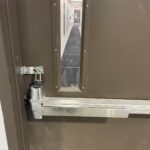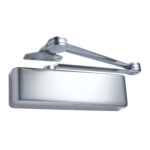Thankfully, we don’t experience many tornadoes here in the Northeast – I actually only remember one tornado scare in my lifetime – on June 1st, 2011. The weatherman was telling the residents of the towns in the tornado’s path when to go into the basement and when the danger had passed. I was grateful that we had a basement to go to, that my family was all here together, and that ultimately the tornado didn’t make it as far as our town. But what if we didn’t have a relatively safe place to go – especially in an area where tornadoes are more common? When I think about our elementary school, I have no idea where the safest location would be…I wonder if the school staff knows?
Before I headed to the Kansas City area last week, I wanted to make sure I was up to speed on any new requirements for tornado shelters, and here’s what I found:
Section 423 – Storm Shelters, was added to the 2009 edition of the International Building Code (IBC), and requires storm shelters to be constructed in accordance with ICC-500. First published in 2008, ICC-500 ICC/NSSA Standard for the Design and Construction of Storm Shelters, was a joint effort between the International Code Council (ICC) and the National Storm Shelter Association (NSSA). The standard provides minimum design and construction requirements for shelters providing protection from storms that produce high winds, hurricanes, and tornadoes.
Here’s the text from the 2009 IBC:
SECTION 423 – STORM SHELTERS
423.1 General. In addition to other applicable requirements in this code, storm shelters shall be constructed in accordance with ICC-500.
423.1.1 Scope. This section applies to the construction of storm shelters constructed as separate detached buildings or constructed as safe rooms within buildings for the purpose of providing safe refuge from storms that produce high winds, such as tornadoes and hurricanes. Such structures shall be designated to be hurricane shelters, tornado shelters, or combined hurricane and tornado shelters.
423.2 Definitions. The following words and terms shall, for the purposes of this chapter and as used elsewhere in this code, have the meanings shown herein.
STORM SHELTER. A building, structure or portions(s) thereof, constructed in accordance with ICC 500 and designated
for use during a severe wind storm event, such as a hurricane or tornado.
Community storm shelter. A storm shelter not defined as a “Residential Storm Shelter.”
Residential storm shelter. A storm shelter serving occupants of dwelling units and having an occupant load not exceeding 16 persons.
Although this section of the IBC references the standards for storm shelters, it doesn’t specify which facilities need to have a storm shelter. Currently, it is up to the state or local jurisdiction to establish the requirements for where storm shelters need to be located, which types of facilities must have them, and how many occupants the shelters must accommodate. But two changes have been approved for the 2015 edition of the IBC which will require new schools and public safety facilities to have storm shelters:
423.3 Critical emergency operations. In areas where the shelter design wind speed for tornados in accordance with Figure 304.2(1) of ICC 500 is 250 MPH, 911 call stations, emergency operation centers and fire, rescue, ambulance and police stations shall have a storm shelter constructed in accordance with ICC 500.
Exception: Buildings meeting the requirements for shelter design in ICC 500.
423.4 Group E occupancies. In areas where the shelter design wind speed for tornados is 250 MPH in accordance with Figure 304.2(1) of ICC 500, all Group E occupancies with an aggregate occupant load of 50 or more shall have a storm shelter constructed in accordance with ICC 500. The shelter shall be capable of housing the total occupant load of the Group E occupancy.
Exceptions:
1. Group E day care facilities.
2. Group E occupancies accessory to places of religious worship.
3. Buildings meeting the requirements for shelter design in ICC 500.
Although the 2015 edition of the IBC will not be adopted by most jurisdictions for quite a few years, it’s possible that local jurisdictions could pull this requirement forward as part of their emergency planning, and could even require some existing facilities to be retrofitted with storm shelters that comply with ICC-500.
ICC 500 includes a map of Shelter Design Wind Speeds for Tornadoes, which shows the area that would have to meet the new storm shelter requirements for schools and public safety buildings. This area encompasses all or part of 22 states:
There’s more to learn about the storm shelter requirements for tornadoes and hurricanes, so watch for upcoming posts on other aspects of storm shelters and wind and impact resistance.
You need to login or register to bookmark/favorite this content.







On June 2, 2000, three F1 tornadoes traveling in a pack tore through my neighborhood in Cortlandt Manor, a town in Westchester County, in the NYC Northern Suburbs.
We were very lucky in that the tornadoes ran along the shore of the lake before splitting up and jumping over a ridge into an adjoining neighborhood where they fizzled-out without doing too much damage. About nine or ten houses, including mine, suffered damage and the neighborhood lost over 350 White Pine trees, some of which were well over 100 feet tall. It took months to clean up and repair all the damage.
Taking everything into perspective, we were very lucky, and got off relatively easy. Some Midwest and Southern communities have been completely destroyed by tornadoes. I can’t imagine trying to come back from that kind of devastation.
I know what you mean. The 2011 tornado that didn’t make it to my house did a lot of damage in Western Massachusetts, and a lot of it is still visible today. Very scary and devastating.